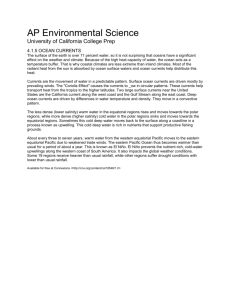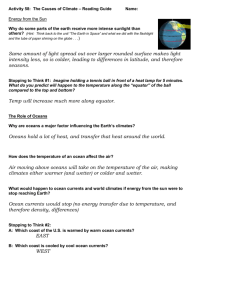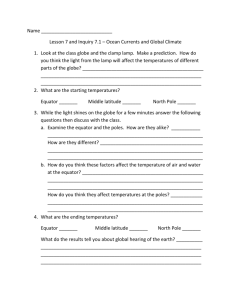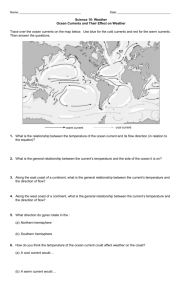The Currents - christinelfaller
advertisement
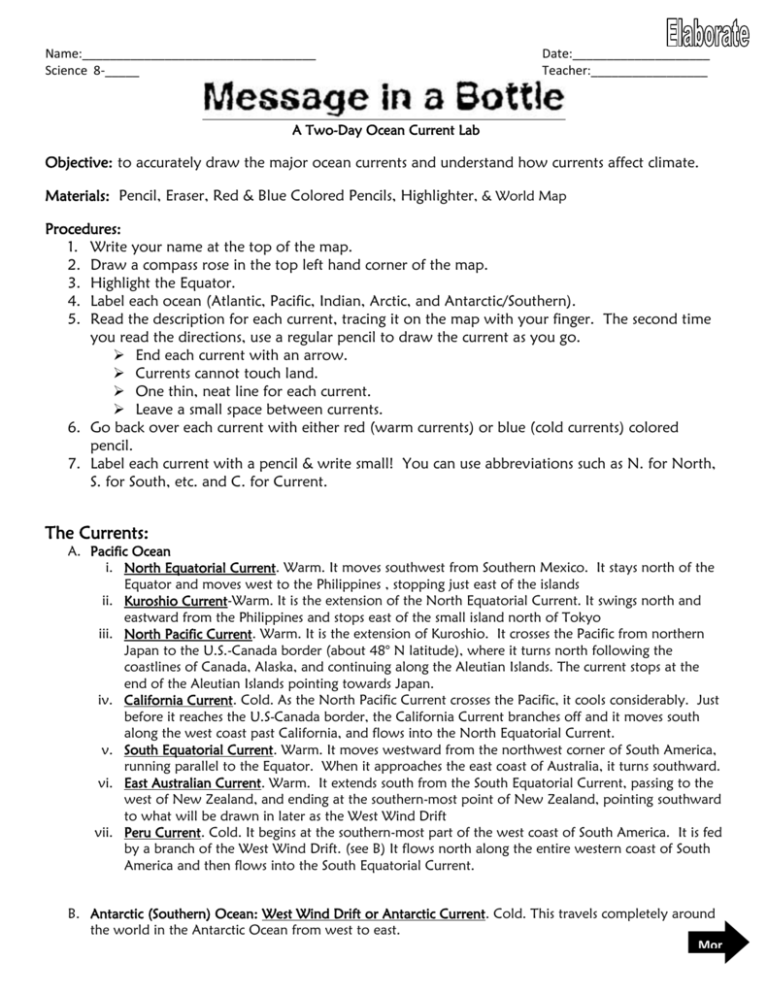
Name:__________________________________ Science 8-_____ Date:____________________ Teacher:_________________ A Two-Day Ocean Current Lab Objective: to accurately draw the major ocean currents and understand how currents affect climate. Materials: Pencil, Eraser, Red & Blue Colored Pencils, Highlighter, & World Map Procedures: 1. Write your name at the top of the map. 2. Draw a compass rose in the top left hand corner of the map. 3. Highlight the Equator. 4. Label each ocean (Atlantic, Pacific, Indian, Arctic, and Antarctic/Southern). 5. Read the description for each current, tracing it on the map with your finger. The second time you read the directions, use a regular pencil to draw the current as you go. End each current with an arrow. Currents cannot touch land. One thin, neat line for each current. Leave a small space between currents. 6. Go back over each current with either red (warm currents) or blue (cold currents) colored pencil. 7. Label each current with a pencil & write small! You can use abbreviations such as N. for North, S. for South, etc. and C. for Current. The Currents: A. Pacific Ocean i. North Equatorial Current. Warm. It moves southwest from Southern Mexico. It stays north of the Equator and moves west to the Philippines , stopping just east of the islands ii. Kuroshio Current-Warm. It is the extension of the North Equatorial Current. It swings north and eastward from the Philippines and stops east of the small island north of Tokyo iii. North Pacific Current. Warm. It is the extension of Kuroshio. It crosses the Pacific from northern Japan to the U.S.-Canada border (about 48° N latitude), where it turns north following the coastlines of Canada, Alaska, and continuing along the Aleutian Islands. The current stops at the end of the Aleutian Islands pointing towards Japan. iv. California Current. Cold. As the North Pacific Current crosses the Pacific, it cools considerably. Just before it reaches the U.S-Canada border, the California Current branches off and it moves south along the west coast past California, and flows into the North Equatorial Current. v. South Equatorial Current. Warm. It moves westward from the northwest corner of South America, running parallel to the Equator. When it approaches the east coast of Australia, it turns southward. vi. East Australian Current. Warm. It extends south from the South Equatorial Current, passing to the west of New Zealand, and ending at the southern-most point of New Zealand, pointing southward to what will be drawn in later as the West Wind Drift vii. Peru Current. Cold. It begins at the southern-most part of the west coast of South America. It is fed by a branch of the West Wind Drift. (see B) It flows north along the entire western coast of South America and then flows into the South Equatorial Current. B. Antarctic (Southern) Ocean: West Wind Drift or Antarctic Current. Cold. This travels completely around the world in the Antarctic Ocean from west to east. Mor e! C. Atlantic Ocean i. Gulf Stream. Warm. Flows east of the Caribbean Sea, northeast along the coast of the United States up the Carolinas, then turns more north-eastward toward the British Isles. Just before reaching the British Isles, it splits. One branch turning south to become the Canary Current (cold) and one branch (still warm) continuing northeast above the Scandinavian countries to become the North Atlantic Drift ii. Labrador Current. Cold. Flows southeast between Canada & Greenland, past Newfoundland, and travels very close to land along the northeast coast of the U.S. At about halfway down the U.S., the current u-turns to the east and heads back up along the coast to Maine. iii. Canary Current. Cold. This southern branch of the Gulf Stream flows southward from Spain along the northern (north of the equator) coast of Africa. iv. Brazilian Current. Warm. This current flows southward along the eastern coast of Brazil. v. Benguela Current. Cold. Branches off the West Wind Drift east of the southern tip of South America. Flows eastward across the Atlantic and north along the coast of Africa to just south of the equator. vi. North Equatorial Current. Warm. Flows north along the equator in a westerly direction between Africa and South America vii. South Equatorial Current. Warm. Flows similar to the North Equatorial Current but is south of the equator. Check it out! Double check your currents for the following: A. Currents tend to flow into each other creating circular patterns known as gyres. B. Currents flow in a clockwise direction in the northern hemisphere and a counterclockwise direction in the southern hemisphere. C. The major equatorial currents flow in a westerly direction. Conclusion Questions: 1. Which current is the only current that flows completely around the world? __________________________ 2. What is the major current of the southeastern and eastern coast of the US? ___________________________ Is it warm or cold? ___________ To which direction does it flow? _______________________________ 3. What is the current that affects the climate of the far northeastern US? ________________________________ Is it warm or cold? _________________ To which direction does it flow? _________________________ 4. What is the major current of the west coast of the US? ______________________________________ Is it warm or cold? _______________ To which direction does it flow? _________________________ 5. Why does the southeastern Canada have a cold climate, whereas England, which is just as far north, has a relatively mild climate? ______________________________________________________________________ ___________________________________________________________________________________________ 6. Benjamin Franklin was the first man to completely map the last part of the Gulf Stream that oceanographers now call the North Atlantic Drift. How did this knowledge help sailors get mail to Europe more quickly? Remember ships had sails back then and used the wind and ocean currents. ______________________________________________________________________________________________ __________________________________________________________________________________________ 7. How did Franklin use his knowledge of the currents to help sailors get the mail and other merchandise back to the northeastern coast of the US from Europe? __________________________________________________ ____________________________________________________________________________________________ Mor e! 8. What effect does the California current have on the climate of the entire west coast area of the US? This includes Washington, Oregon, and California. ___________________________________________________ 9. Compare and contrast the direction of the circulation (the gyres) for the northern and southern hemispheres. ________________________________________________________________________________ 10. Which current in the Atlantic is the counterpart to the California current in the Pacific? Note: Counterpart means the two currents will closely resemble each other; meaning that they will have similar temperatures and __________________________________________________________________________ ____________________________________________________________________________________ flow patterns. Messages in Bottles Picture yourself standing at the shore of each of the places listed in the chart. You throw a bottle with a message in it into the ocean. Where might the ocean’s currents carry your message? To find out, use the Ocean Currents map provided by your teacher and the class set of World Maps as a reference. Complete the chart by writing the name of the ocean currents that would carry your message in the bottle. MESSAGE STARTS HERE MESSAGE ENDS HERE California Philippines Florida Alaska Morocco United Kingdom Russia Florida Indonesia Kenya (East coast of Africa) Japan Washington State (West coast of US) Venezuela NAME OF OCEAN CURRENT(S) Mexico Optional Challenge: Below, add one more entry of your own to the chart. Try to use a different ocean current from the ones used above. Name: ________________________________
